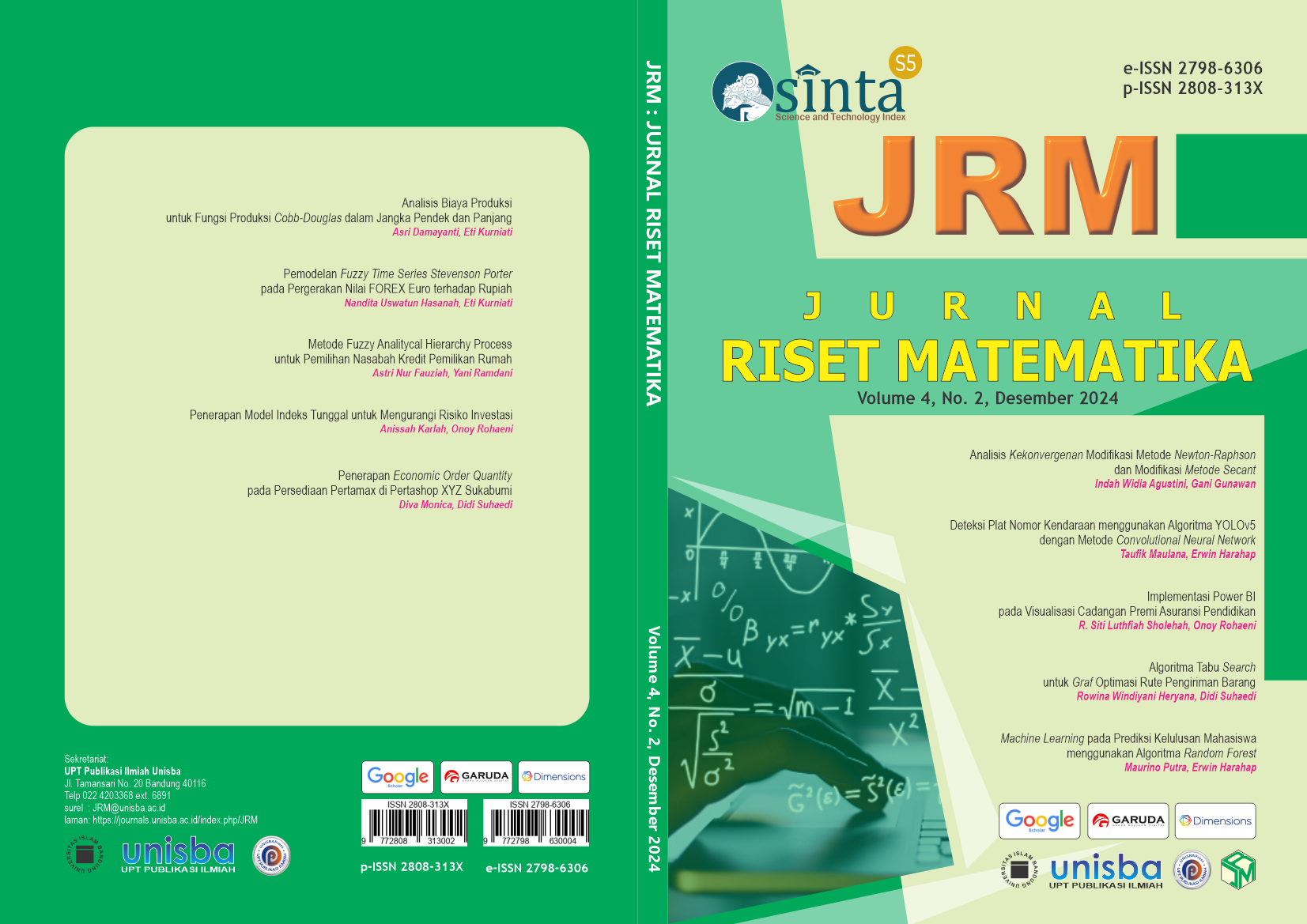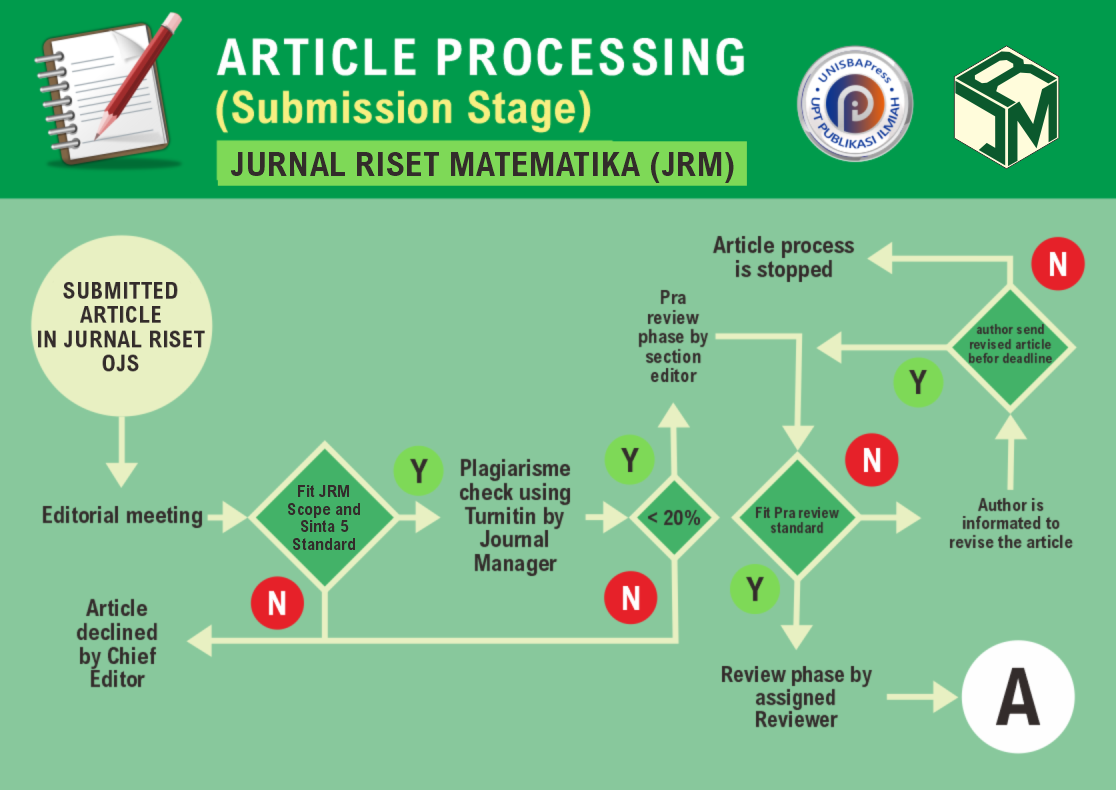Analisis Kekonvergenan Modifikasi Metode Newton-Raphson dan Modifikasi Metode Secant
DOI:
https://doi.org/10.29313/jrm.v4i2.5041Keywords:
Modifikasi Newton-Raphson, Modifikasi Secant, KekonvergenanAbstract
Abstrak. Metode numerik merupakan algoritma pendekatan. Kekonvergenan dalam metode numerik merupakan kondisi di mana suatu barisan hampiran konvergen ke solusi sejati. Dengan kata lain, kekonvergenan ialah kondisi di mana suatu proses iterasi mendekati suatu nilai tertentu dengan tingkat kesalahan yang lebih kecil. Tujuan penelitian ini adalah menganalisis kekonvergenan metode Newton-Raphson, metode Secant, modifikasi metode Newton-Raphson dan modifikasi metode Secant serta melihat perbedaan kecepatan konvergensi dari masing-masing metode. Pada penelitian ini, menganalisis kekonvergenan metode numerik menggunakan deret Taylor untuk menguraikan fungsi di sekitar titik iterasi, sehingga dapat memperkirakan kesalahan aproksimasinya. Orde konvergensi dapat ditentukan dengan melihat pangkat dari galat iterasi sebelumnya. Hasil penelitian menunjukkan bahwa orde konvergensi metode Newton-Raphson, metode Secant, modifikasi metode Newton-Raphson dan modifikasi metode Secant secara berturut-turut yaitu bersifat kuadratik, superlinear, kubik, dan kuadratik. Modifikasi dari masing-masing metode menunjukkan peningkatan orde konvergensi daripada sebelum metode dimodifikasi. Metode dengan orde konvergensi yang semakin besar memberikan indikasi tingkat konvergensi akan semakin cepat.
Abstract. Numerical methods are algorithmic approaches. Convergence in numerical methods is a condition where a sequence almost converges to a true solution. In other words, convergence is a condition where an iteration process approaches a certain value with a smaller error rate. This research aims to analyze the convergence of the Newton-Raphson method, the Secant method, a modification of the Newton-Raphson method, and a modification of the Secant method and to see the differences in the convergence speed of each method. In this research, analyzing the convergence of numerical methods uses the Taylor series to describe the function around the iteration point so that it can describe the approximation error. Order convergence can be determined by looking at the power of the previous iteration error. The research results show that the order convergence of the Newton-Raphson method, Secant method, modified Newton-Raphson method, and modified Secant method are quadratic, superlinear, cubic, and quadratic, respectively. Modifications of each method show improvement or convergence compared to before the method was modified. Methods with greater convergence orders indicate that the level of convergence will be faster.
References
M. Panjaitan, “Pemahaman Metode Numerik Menggunakan Pemprogrman Matlab (Studi Kasus : Metode Secant),” Jurnal Teknologi Informasi, vol. 1, no. 1, 2017.
P. Batarius, A. Aristo J, and Sinlae, “Nilai Awal pada Metode Secant yang Dimodifikasi dalam Penentuan Akar Ganda Persamaan Non-Linear,” Jurnal Ilmiah MATRIK, vol. 21, no. 1, Apr. 2019.
S. Putra, D. A. Arvina, and M. Imran, “Kombinasi Metode Newton dengan Metode Secant untuk Menyelesaikan Persamaan Nonlinear,” vol. 2, pp. 23–29, 2011.
G. Gunawan, “Multiplisitas Newton dan Titik Tetap Atraktif dalam Menentukan Kekonvergenan,” Jurnal Ilmiah MATRIK, vol. 22, no. 3, pp. 333–338, Dec. 2020.
A. Agustina and Wartono, “Modifikasi Metode Iterasi Berorde Tiga dengan Orde Konvergensi Optimal,” Majalah Ilmiah Matematika dan Statistika, vol. 23, no. 1, pp. 15–26, 2023.
R. V Dukkipati, Numerical Methods. New Age International Limited, 2010.
R. Munir, Metode Numerik. Bandung: Informatika Bandung, 2015.
L. Fatmawati and Wartono, “Orde Konvergensi Varian Metode Hansen-Patrick Dua Parameter Untuk Menyelesaian Persamaan Nonlinear,” Prosiding SainsTeKes Semnas MIPAKes UMRi, vol. 1, pp. 16–23, Aug. 2019.
Z. Lega, Agusni, and S. Putra, “Metode Iterasi Tiga Langkah dengan Orde Konvergensi Lima Untuk Menyelesaikan Persamaan Nonlinear Berakar Ganda,” JOM FMIPA, vol. 1, no. 2, pp. 91–101, Oct. 2014.
J. R. Senning, “Computing and Estimating the Rate of Convergence,” Department of Mathematics and Computer Science, Gordon College, 2019.
J. R. Sharma, R. K. Guha, and R. Sharma, “Some modified Newton’s methods withfourth-order convergence,” Pelagia Research Library, vol. 2, no. 1, pp. 240–247, 2011.
S. C. Chapra and R. P. Canale, Numerical Methods for Engineers, Seventh. New York: McGraw-Hill Education, 2015
S. A. Savitri and D. Suhaedi, “Penerapan Inference Fuzzy Mamdani dalam Seleksi Penerima Bantuan Sosial Tunai Kabupaten Belitung Timur,” J. Ris. Mat., pp. 163–172, Dec. 2022, doi: 10.29313/jrm.v2i2.1383.
G. Enzellina and D. Suhaedi, “Penggunaan Metode Principal Component Analysis dalam Menentukan Faktor Dominan,” J. Ris. Mat., pp. 101–110, Dec. 2022, doi: 10.29313/jrm.v2i2.1192.
Y. P. Yulinar and G. Gunawan, “Metode Sainte Lague untuk Konversi Suara terhadap Kursi Parlemen pada Pileg,” J. Ris. Mat., vol. 4, no. 1, pp. 29–36, Jun. 2024, doi: 10.29313/jrm.v4i1.3599.
Hana Mumtaz and I. Sukarsih, “Taksiran Matriks Teknologi untuk Menentukan Sektor Unggulan di Suatu Wilayah Menggunakan Metode RAS,” J. Ris. Mat., vol. 1, no. 2, pp. 137–144, Feb. 2022, doi: 10.29313/jrm.v1i2.485.
S. T. Utami Putri and E. Kurniati, “Prediksi Harga Saham Menggunakan Jump Diffusion Model dan Analisis Value at Risk,” J. Ris. Mat., pp. 131–140, Dec. 2023, doi: 10.29313/jrm.v3i2.2832.
G. N. Fawzi and Y. Ramdani, “Analisis Model Getaran Pegas Teredam Kendaraan Bermotor dengan Metode Runge-Kutta Gill dan Milne,” J. Ris. Mat., no. 1, pp. 17–28, Jun. 2024, doi: 10.29313/jrm.v4i1.3598.
S. Fratama and E. Kurniati, “Penerapan Model CAPM dan Arbitrage Pricing Theory dalam Menghitung Return Indeks Saham IDX30,” J. Ris. Mat., pp. 37–44, Jul. 2023, doi: 10.29313/jrm.v3i1.1736.
S. Zein and G. Gunawan, “Prediksi Hasil FIFA World Cup Qatar 2022 Menggunakan Machine Learning dengan Python,” J. Ris. Mat., pp. 153–162, Dec. 2022, doi: 10.29313/jrm.v2i2.1382.













